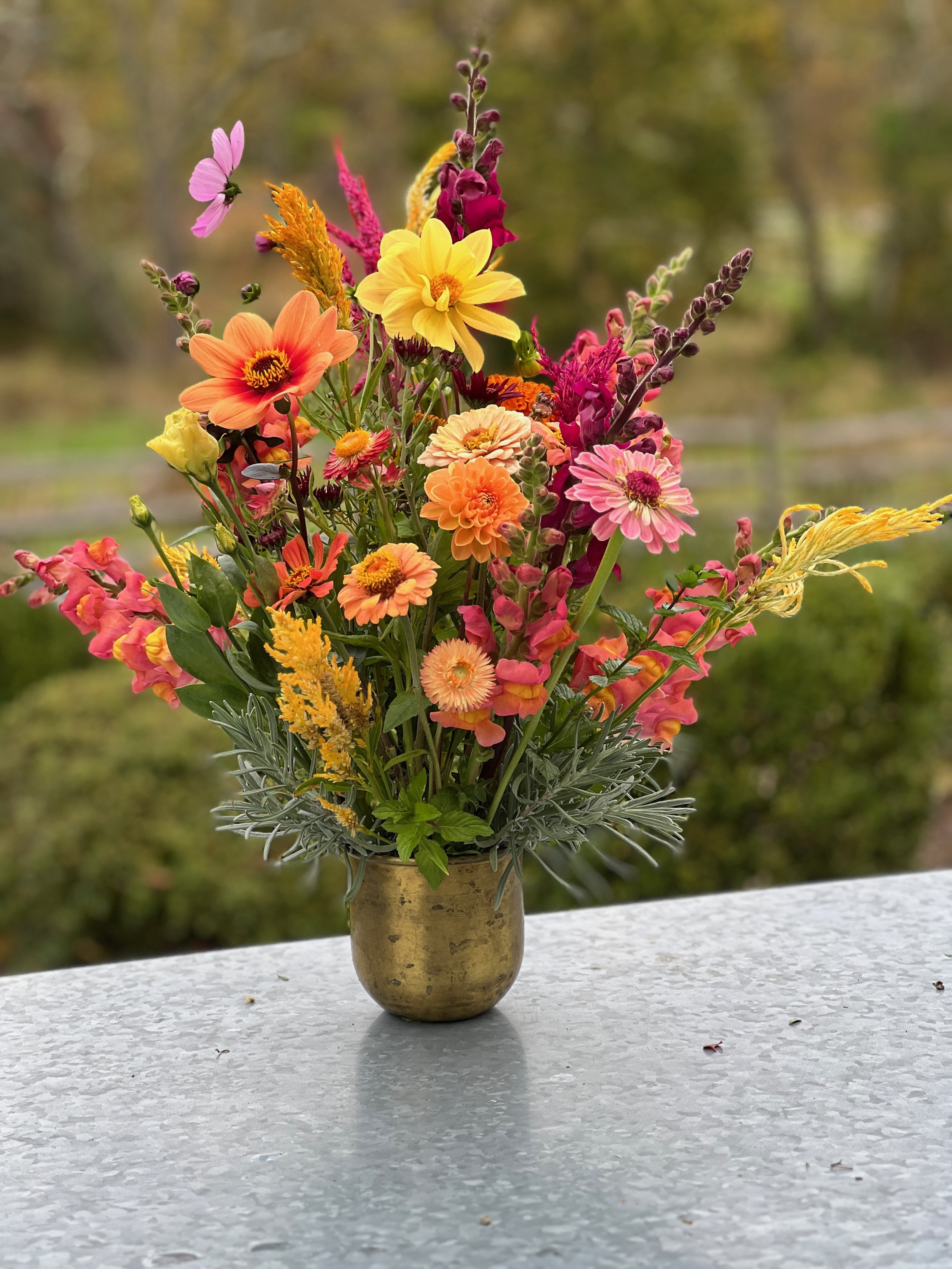Frost and the Power of Endings
As I looked out my bathroom window this morning, I saw the tell-tale sign. It looked like a light dusting of powdered sugar all over the yard. My yard is in a hollow, lower than my flower field, and the coldest temperature last night was only 37; there was a chance my flowers were spared. A brisk walk up to the field told me what I already knew, my remaining flowers had been kissed by frost. It makes sense, it is October 24 after all, pretty much on the nose for our expected frost date. Still I’m never quite prepared for the end of the season. It feels like a Sunday afternoon after a holiday weekend, when the kids leave our home headed to their far-flung cities. I’m tired from the celebration, grateful for the beauty and communion, and already longing to do it all again.
Dahlia with a light frost that will likely soon turn black.
That is the first frost, a wild conflation of relief and sorrow. Relief that a deadline has passed. There can be no more “quickly before the frost” chores, relief that the season is over and my aching knees and back will have more time to rest. There is also sorrow that I won’t be starting my day harvesting the flowers that serve as my morning reminder to notice, to pause, and to appreciate.
Frost also indicates the coming of winter, the inevitable reminder of the passing of another year. I’ve always had a complicated relationship with winter and the cold. It’s a season I’ve struggled to make peace with. I’m also better at beginnings than I am at endings. I never liked the end of a school year, or moving, or a funeral. But I’m trying to learn how to appreciate endings. Fall gives me some practice. It provides a gentle lead up to the end of the season. The sun is lower and illuminates the clinging dew and makes each blade of grass sparkle. Maybe it is the change in the angle of the sun, or the cooler morning temperatures, but whatever it is, the glistening dew drops of October sparkle in a way that evokes the magic fairylands I created in my mind as a child. I admire that change, but that appreciation falls short when it comes to the first frost. That’s a hard stop, a clear ending, and it makes me bristle.
Strawflower
While my meditation practice reminds me to stay in the moment, neither looking back or staring into the future, the first frost drags me in both directions. As the season ends, I can’t help but think about what I’ve learned and what I’ve lost, and it leaves me longing for the next season so I can start again.
I learned a lot about growing this year. I learned that dahlias need water, but not too much water. I learned that you can most certainly have a frost in May, after the generally considered last frost date has passed. I learned that planting 1,000 perennials over the course of two weeks is too hard on my 58-year-old body. I learned that strawflowers are the duct tape of the flower world, useful in every situation, in every arrangement, and produce flowers for a very long time.
Part of the flower field a week before the frost
I also learned other lessons. I read somewhere that working in a garden teaches you whatever lesson it is that you need to learn. For me, one of the lessons I’m always trying to learn is the value of endings. One of their powers is perspective. The slowdown of late fall and almost-winter gives me the perspective to take time to rest and reflect, and put the so-called hard things into perspective. Once the frost descends so too do all the end of season reckonings. The things that seemed so hard in the heat and demands of the season—keeping the dahlias upright, discovering and planting the natives that will do best in my space, finding the customers who will appreciate sustainably-grown flowers-–don’t seem so daunting once they are in the past.
The real hard things don’t take place in my flower field. The real hard things are a world that is ever-warming, a world where there seems to be more hate than kindness, a world where differing beliefs and ideas drive wedges through human connection. The loss of the blooming season reminds me that what seemed so hard in the summer was actually a gift. The end allows me to realize the beauty of planting a seed that eventually blooms and provides a place to nurture birds and insects, and a harvestable crop that brings beauty into someone’s home. This is a gift. What seemed hard in the heat of July, now seems like a small miracle.
American toad, also contemplating winter?
While spring is a long way away, and the ending that is winter is bearing down, there is much that reminds me that the ending is what allows the beginnings to be so full of hope. I have much to remind me of a new beginning. I’ve planted bupleurum and orlaya, campanula and scabiosa, forget-me-nots and larkspur, nigella and bachelor's button. They will grow a bit more this fall, then hunker down for the winter, only to grow again and bloom in May. Patiently awaiting their burst of growth reminds me how lucky I am to witness it. Winter gives me time to discern what is really hard, and what is a temporary challenge. Those tiny plants are also a small reminder that there’s another beginning not far away.
With all I’ve learned about flower farming this season, I’m more excited than ever to be sharing flowers with everyone that supported our farm this year (and maybe some new folks too!).
October sunrise
Flowers to match






